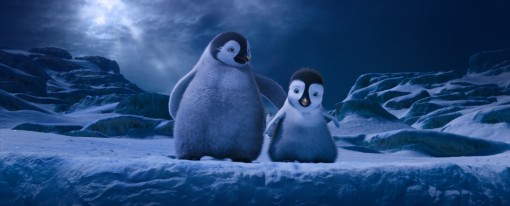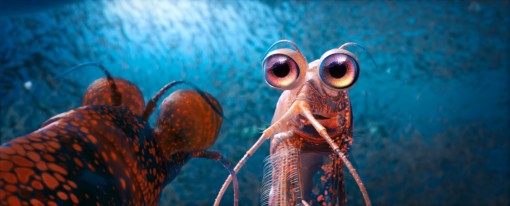George Miller’s Oscar-winning, soft-shoeing penguin crew is back in the new 3-D adventure, Happy Feet 2.
Back in 2006, audiences around the world got their toes tapping for an inventive CG animated feature called Happy Feet. The film shook up the toon world and sealed its reputation by beating Pixar’s Cars and capturing the Best Animated Feature Oscar. Now, five years later, Mumble the penguin is back to shake some tail feathers in Happy Feet Two, a stereoscopic 3-D adventure from Warner Bros., brought to life by Australia’s Dr. D Studios.
In this outing, Mumble (voiced by Elijah Wood) has a little son of his own, Erik (E.G. Daily) who is afraid to follow in his father’s tap-steps. When Erik runs away, he encounters The Mighty Sven—a high-flying puffin, played by Hank Azaria—with whom Mumble feels he can’t compete for his son’s affection. But when powerful forces rock their Antarctic world, Mumble bands together penguins, puffins and even tiny krill and massive elephant seals to save their home.

The icy spectacle also stars Robin Williams, Alecia Moore (P!nk), Brad Pitt, Matt Damon, Sofia Vergara, Common, Hugo Weaving, Richard Carter, Magda Szubanski, Anthony LaPaglia and Benjamin “Lil P-Nut” Flores, Jr.
Accomplished Australian director George Miller (Babe: Pig in the City, Lorenzo’s Oil, Mad Max) helms the sequel and also also penned the script with Warren Coleman, Gary Eck and Paul Livingston.
“In this digital era, animation is probably making the best stories or some of the best stories around,” says Miller, a relative newcomer to Toon Town who tags Disney’s Pinocchio as his biggest inspiration. “What’s always been the challenge is to tell really good stories … In particular with animation I think in many ways it can lead in the quality of the storytelling because the films are so hand-crafted.”

Making Mumble’s Sweet Moves
With five years of tech advances and a comfortable familiarity with the characters behind them, Miller and his animation team at Dr. D Studios (lead by animation director Rob Coleman and fx supervisor Ben Simons) were able to create a broader, more immersive world across a wider scale, bring new creatures to life and augmenting the expressiveness and physicality of their feathered stars. Not to mention weaving in spectacular stereoscopic elements.
The original Happy Feet wowed audiences with its unique look, particularly in its icy oceanic settings. A key goal for the design and lighting teams, according to Coleman, was to make audiences feel that they had returned to Mumble’s world. Art director David Nelson strived to create a stylized yet near photorealistic look. “The snow, the skies and the water are all rendered incredibly close to the real world, but still retain a magical quality because the colors and the saturations have been heightened,” Coleman, an ILM veteran and two-time Oscar nominee, explains. Intrepid artists even donned their Antarctic scientist caps to closely research how snow and ice move, form and reflect light.
The sheer scope of the film created challenges for the crews—which maxed out at about 75 animators and 50 vfx artists as the height of the three-year production. Tons of water, ice and snow effects that Coleman says would not have been possible in the first film, including an iceberg collapse and avalanche sequence, kept the vfx team busy. Meanwhile the animators relied on proprietary tools supervised by Dr. D’s Carsten Kolve to shepherd massive herds of penguins, seals and other creatures. According to crowd director Greg van Borssum, more than 16 million characters were animated by the crowd teams in over 600 shots—making each crowd animator responsible for about 950,000 characters, or twice the population of Tasmania.

And two tiny characters proved to be especially big challenges.
Miller says that the increase in detail, photorealism and effects quality possible in this film are embodied by the flick’s tiniest characters: Bill and Will the Krill (voiced by Pitt and Damon). The two near-microscopic pals are part of a huge swarm, but decide to strike out for the wide world above the waves, broadening the range of perspectives for the audience. Plus, they’re just complicated little buggers.
“The krill were some of the more challenging characters due to the number of arms and legs they have,” Coleman notes. “They had complicated skeletons and constantly needed to be moving.” Miller adds that the krill are not only translucent, but also bioluminescent: “You can see enormous detail which you would not normally see—I don’t think we could have even got close to it five years ago.”

Miller says that the need to tell a bigger, better story and build a pipeline around what they wanted to accomplish was what inspired him to form the Dr. D group, which he founded with Dough Mitchell (Miller, his brother Bill Miller and Mitchell are all producers on the sequel). Animal Logic, who provided the animation for the first film, contributed a few shots, but the new studio delivered all the rest, save end titles. The total came to about 1,400 shots done in-house in Sydney. In addition to many proprietary tools developed by the R&D crew, the team relied primarily on Maya, Houdini, Naiad, MotionBuilder and Nuance.
Dancing into the Third Dimension
The most obvious shift from the first flick is the stunning stereoscopic 3-D implemented in the sequel. While Coleman emphasizes that the goal was never “to make a point that you were watching a stereo film,” both the director and animation director are enthusiastic about how the use of 3-D brings audiences deeper into Mumble’s world.
Coleman credits stereo supervisor Jason Fairley with striking the right balance, allowing viewers to be comfortably immersed in the story without being overwhelmed by a stampede of stereoscopic effects. Fairley worked closely with Miller to determine when the technology would be appropriate, and the result is a 3-D film that is emotional and thrilling by turns—but only when the story demands it.

Miller, whose admiration for artfully implemented 3-D is traced back to its sparing use in Hitchcock’s Dial M for Murder, is a huge enthusiast of the technology.
“[During production] I hated the end of the stereo reviews and having to take off my glasses and go out into the real world, and it doesn’t have that immersive quality—it’s like looking at a flat screen!” he recalls. He compares the experience of watching Happy Feet Two in 3-D to being inside an underwater bathoscope, moving through a new world along with the camera. “It really puts you into that word in a way that’s kind of an extrapolation rather than a reality,” he muses.
The helmer, fresh from his first taste of 3-D production, picks out three especially dramatic uses of the technology in his animated epic. Chiefly, the flying characters, such as Azaria’s heroic puffin, make taking to the air a central element of the story. As the 3-D camera follows the bird through the air, the audience is right there in his wake.

Secondly, he again notes those curious, comedic krill. “Krill exist in massive swarms of billions and billions, and these two decide to leave the swarm—so anything underwater and then out in the air and on the ground becomes very spectacular in terms of 3-D, because we see it from a very micro perspective,” he explains.
A third element made particularly stunning with the golden stereo touch is the vast landscape of Antarctica, rendered so carefully by the dedicated artists. Miller is especially awed by the towering edifices of ice and snow and the way 3-D helps one to feel as if you are really standing (or swimming, or dancing) amongst them.
Whatever Moves You
For animation director Coleman, the most rewarding part of the break-neck production was seeing the final product begin to take shape. ‘There are hundreds of women and men who work in different departments; art, design, editorial, sound, model, surfacing, animation, crowd, effects, music, lighting and compositing. The collective work comes together over years, and as it does it is really very exciting.”

“Normally by the time you get to the end of a film you’re pretty burnt out and you don’t even see it any more, particularly in animation when you’ve seen literally every frame hundreds if not thousands of times,” Miller divulges. “You end up with a kind of Stockholm Syndrome where you’re held hostage and almost get addicted to it in a crazy way. I’m very surprised I can’t remember experiencing this on another film.” For the director, what most surprised him about his familiar little feathered pals was how emotional the characters’ relationships became. When we spoke, Miller had just listened to the naked score for the first time:
“I made a comment to the composer, John Powell, ‘How is it it’s such a warm and emotional score?’ And he said, ‘Well, you know, there are so many scenes that have that quality, so it required the music to follow in that vein.’” Powell earned a Grammy nomination for his work on the first Happy Feet, and an Oscar nod for DreamWorks’ How to Train Your Dragon. “But, to be honest, that’s for audiences to assess, not really for me to say!”
When asked if there was added pressure working on the sequel to an Oscar-winning film, Coleman shrugs the question off. “The first film was excellent and well-received by audiences; the goal was always to make a film as good or better. I do think Happy Feet Two will make it into the Awards race … but I guess we will have to wait and see.”

Who knows, maybe Erik the penguin will follow in his father’s footsteps in more than just a love of dance.
Warner Bros. released Happy Feet Two on November 18, it has since grossed $56,700,101 at U.S. box offices.




















